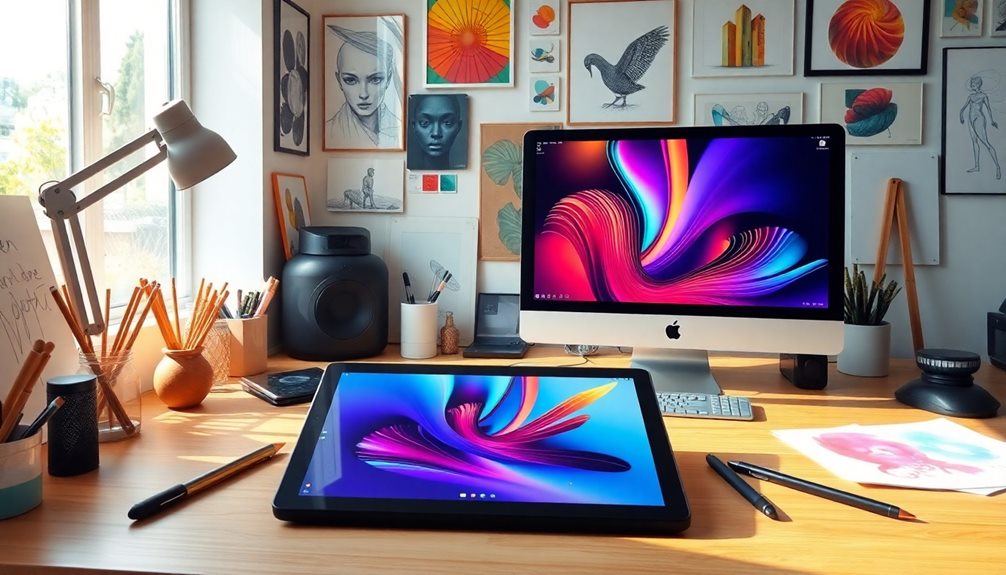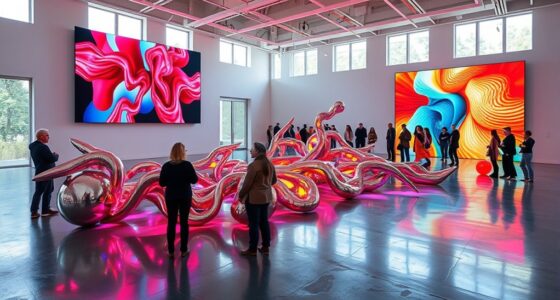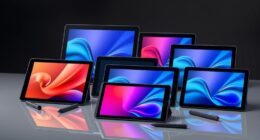A digital art analysis guide helps you reveal the deeper meanings behind various artworks. Start by examining compositional techniques and visual elements like color and texture. It's important to reflect on the artist's background and historical context for a fuller understanding. Engaging in methods like "Slow Looking" can enhance your appreciation. Technologies utilized in digital art, such as Photoshop and Procreate, also influence outcome. Familiarizing yourself with tools and best practices can elevate your creative journey. Stick around to discover essential tips and techniques that will sharpen your analytical skills and enrich your artistic experience.
Key Takeaways
- Utilize the "Slow Looking" method to engage deeply with digital art, focusing on themes and symbols within the work.
- Analyze visual elements such as line, color, shape, and texture to understand the artist's intent and composition.
- Investigate the artist's background and historical context to gain insights into the work's deeper meanings.
- Familiarize yourself with digital art techniques, such as layers and color theory, to enhance your analysis.
- Explore the impact of technological tools and software on the creation and evolution of digital art.
Purpose of Art Analysis

The purpose of art analysis is to deepen your understanding of the compositional devices and artistic choices that shape a work. Engaging in art analysis enhances your appreciation of visual elements, helping you navigate your digital art journey with greater insight.
You'll move beyond merely describing what you see to exploring the deeper meanings behind the artwork. Through critical analysis, you'll uncover how various artistic choices impact the viewer's experience.
Developing these skills is essential for art studies; it allows you to distinguish between mere description and thoughtful interpretation. Contextual understanding plays an important role here, as the historical and cultural background of an artwork greatly influences its meaning.
A well-structured written analysis, supported by visual aids, can clarify complex artistic concepts. It's important that your personal opinions are backed by evidence, ensuring credibility and academic integrity in your interpretations.
Techniques for Analyzing Art

Understanding art analysis opens the door to various techniques that can enhance your appreciation of digital artworks. One powerful method is "Slow Looking," which encourages you to engage deeply with the artwork. Take your time observing the visual elements and noting your emotional responses before diving into more detailed analysis.
Start by focusing on the subject matter. Identify the key themes and symbols present in the digital paintings, as they often reveal the narrative and emotional impact of the piece.
Next, investigate the artist's background and the historical context surrounding the artwork; these factors greatly influence its meaning and style.
When you analyze the visual elements—such as line, color, shape, texture, and composition—pay close attention to how these components interact. This interaction creates a cohesive artwork that communicates the artist's intent.
Understanding Digital Art

Digital art opens up a world of creativity, blending technology with artistic expression. As you explore this fascinating medium, you'll discover how digital art creation has transformed the art landscape.
Digital artists seeking innovative ways to express themselves can embrace various types of digital artwork, including:
- Digital painting
- Animation
- Photography
- Pixel art
This extensive guide helps you understand the evolution of digital art, which has its roots in the 1960s and has greatly expanded since then.
With powerful tools like Photoshop, Illustrator, and Procreate, artists can push boundaries that traditional art often can't accommodate. This environment encourages experimentation and risk-taking, fostering a unique creative journey.
Moreover, the rise of NFTs has further revolutionized the digital art market, opening new avenues for monetization and ownership.
When you engage in an analysis of the artwork, consider not only the techniques and styles used but also the digital medium's influence on the artist's vision.
Understanding digital art means recognizing its potential to challenge conventions and redefine artistic expression in exciting ways.
Essential Tools for Artists

When choosing essential tools for your digital art journey, the right device can make all the difference.
You'll want to explore various drawing tablets and software options that fit your style and needs.
Let's compare some popular choices to help you create your best work.
Device Selection Considerations
How do you choose the right device for your digital art projects? Your device selection can greatly influence your artistic process. Here are some key considerations to keep in mind:
1. Type of Work: If you're into digital painting, drawing tablets like the Deco MW Pen Tablet offer a natural drawing experience.
For more complex work, a computer can handle robust software programs.
2. Pressure Sensitivity: Look for pen tablets with high pressure sensitivity, ideally around 8192 levels.
This gives you more control over your brush strokes, allowing for nuanced artwork.
3. Budget: Balance your budget with your needs.
The Artist 12 (2nd Gen) tablet is a great option, offering a fully laminated screen and express keys for enhanced functionality without breaking the bank.
4. User Experience: Beginners might find tablets more user-friendly and portable, while computers can support powerful applications like Photoshop and Illustrator, making them ideal for advanced projects.
Recommended Software Options
Exploring the right software can considerably enhance your digital art experience. Whether you're into image editing, graphic design, or digital drawing, choosing the right tools is essential. Here's a quick overview of some recommended software options:
| Software | Key Features | Best For |
|---|---|---|
| Photoshop | Extensive creative options, precise control | Image editing & visual art |
| Illustrator | Vector-based, scalable without loss of quality | Graphic design & illustrations |
| Procreate | Diverse brushes, layering capabilities | Intuitive painting on iPad |
| Krita | Customizable brushes, open-source | Digital painting for all levels |
| AI Tools | Unique art generation, automates tasks | Expanding creative possibilities |
Each of these software options offers unique advanced features to support your artistic endeavors. Photoshop stands as the industry standard, while Illustrator excels in scalability. Procreate's user-friendly interface makes it a top choice for iPad users, and Krita invites both beginners and pros with its customizable tools. Finally, AI tools like Midjourney can automate certain tasks, helping you explore new creative avenues. Immerse yourself in these options to elevate your digital art journey!
Drawing Tablets Comparison
Choosing the right software can set the stage for your digital art journey, but having the right hardware is just as important.
Drawing tablets are essential tools that greatly enhance your ability to create and respond to your artwork. Here's a quick guide to help you compare some popular options:
- Pen Tablets: The Deco MW offers an 8×5 inch drawing surface with pressure sensitivity and customizable keys, providing a natural drawing experience akin to traditional painting.
- Display Tablets: The Artist 12 (2nd Gen) features a fully laminated screen, USB-C connectivity, and express keys, enhancing usability and precision.
- Budget Considerations: Think about your budget, as it can dictate the features and quality of the tablet.
- Portability and Size: Consider the size and portability based on the type of artwork you plan to create; these factors impact your workflow and comfort.
When selecting a drawing tablet, focus on a responsive stylus and high-resolution display.
These features are vital for achieving detailed artwork and allow you to analyse your creations effectively.
Investing in the right tools can truly elevate your digital art experience.
Best Practices for Creation

Creating digital art requires a thoughtful approach, and having a well-defined concept can greatly enhance your artistic journey. Start by brainstorming ideas that convey your intended message, ensuring a clear direction for your work. This step minimizes distractions and keeps your focus sharp.
Master the fundamentals of digital art; strong basic skills are essential for executing advanced techniques effectively. Familiarize yourself with traditional painting methods and apply that knowledge to your digital creations. Pay attention to your choice of colours—understanding their interactions can markedly impact your visual results.
Consider using a mid-tone background to enhance value perception and improve composition clarity. This practice allows for better contrast and balance in your artwork.
Don't forget to regularly practice and seek constructive feedback from peers. This process will facilitate your skill development while keeping your passion alive.
Advanced Digital Art Techniques

When you immerse yourself in advanced digital art techniques, mastering the use of layers is essential for enhancing your creative workflow. Layers allow you to separate elements and make non-destructive edits, giving you the freedom to experiment without fear of losing your original work.
Here are a few key techniques to reflect on:
- Customization of Brushes: Tailor your brushes in software like Photoshop or Procreate to create unique textures and styles that fit your vision.
- Understanding Color Theory: Utilize principles like complementary and analogous colors to enhance the emotional impact and harmony of your compositions.
- Implementing Ambient Occlusion: This technique simulates how light interacts with objects, adding a layer of realism to your artwork.
- Depth of Field: Employing depth of field can create dynamic perspectives, drawing attention to specific elements within your piece.
Additionally, incorporating 3D elements from software like Blender can push your artwork beyond traditional boundaries.
Frequently Asked Questions
How Do I Analyse My Own Artwork?
To analyze your artwork, revisit it with fresh eyes, noting emotional responses. Break down elements like color and shape. Research context and techniques, then reflect on influences, documenting insights for future growth and improvement.
What Is the 4 Step Method to Analysing Art?
When it comes to analyzing art, you've got to break it down into four steps: observe, describe, interpret, and evaluate. Each step helps you get a clearer picture, and it's a real game changer!
How to Study for Digital Art?
To study for digital art, create a structured plan focusing on fundamentals. Use online resources, join communities for feedback, replicate favorite artists, and document your progress to track growth and improvement effectively.
How to Start an Art Analysis?
Like a detective uncovering clues, start your art analysis by observing the piece closely. Note your feelings and impressions, then explore its subject matter and context to deepen your understanding and appreciation of the artwork.
Conclusion
As you dive deeper into digital art analysis, remember that each piece holds secrets waiting to be disclosed. You've learned the techniques, tools, and best practices, but the true magic lies in what you'll create next. Imagine the stories hidden within your own work, waiting for someone to decode them. So, what will your next masterpiece disclose? The journey of discovery has just begun, and the canvas is all yours—what mysteries will you reveal?









